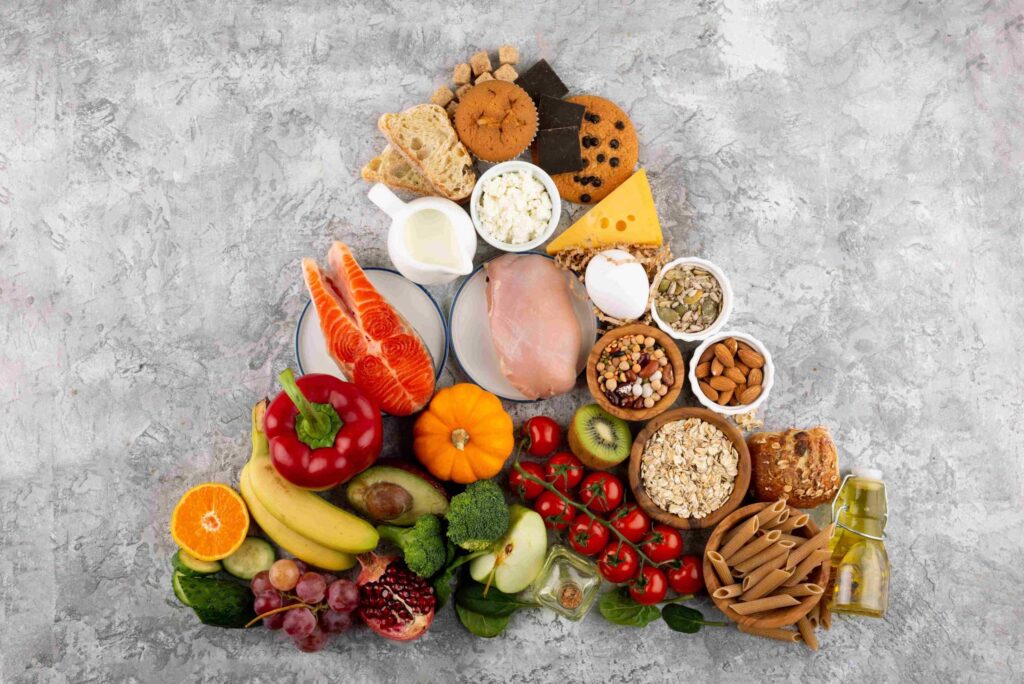Healthy Eating Basics, In a world saturated with processed foods, fad diets, and conflicting nutritional advice, it’s easy to feel overwhelmed and confused about what constitutes healthy eating. Stripped down to its core, healthy eating is about fueling your body with the nutrients it needs to thrive, promoting overall well-being, and reducing the risk of chronic diseases. It’s not about deprivation or restrictive rules, but rather about making informed choices that support your individual needs and lifestyle.
This comprehensive guide will delve into the foundational principles of healthy eating, providing you with a clear understanding of essential nutrients, balanced meal planning, mindful eating habits, and practical strategies to integrate healthy eating into your daily routine.
I. Understanding the Building Blocks: Essential Nutrients
The food we consume is broken down into essential nutrients that provide our bodies with energy, support growth and repair, and regulate various bodily functions. These nutrients are broadly categorized into macronutrients and micronutrients.
- Macronutrients: These nutrients are required in larger quantities and provide the body with energy in the form of calories.
- Carbohydrates: Often vilified, carbohydrates are the body’s primary source of energy, especially for the brain and nervous system. They are found in grains, fruits, vegetables, and legumes.
- Complex Carbohydrates: These are slowly digested, providing sustained energy and fiber. Examples include whole grains (brown rice, quinoa, oats), starchy vegetables (sweet potatoes, corn), and legumes (beans, lentils).
- Simple Carbohydrates: These are quickly digested, providing a rapid burst of energy. Examples include refined grains (white bread, white rice), sugary drinks, and processed snacks. While naturally occurring sugars in fruits and vegetables are acceptable, limiting processed and refined simple carbohydrates is crucial for maintaining stable blood sugar levels and preventing weight gain.
- Proteins: Crucial for building and repairing tissues, enzymes, and hormones. They are found in animal products (meat, poultry, fish, eggs, dairy) and plant-based sources (legumes, nuts, seeds, tofu).
- Complete Proteins: Contain all nine essential amino acids, which the body cannot produce on its own. Animal sources are typically complete proteins.
- Incomplete Proteins: Lack one or more essential amino acids. Plant-based sources can be combined to create complete proteins (e.g., rice and beans).
- Aim for lean protein sources such as chicken breast, fish, beans, and lentils to minimize saturated fat intake.
- Fats: Essential for hormone production, cell structure, and absorption of fat-soluble vitamins (A, D, E, K). They are found in oils, nuts, seeds, avocados, and fatty fish.
- Unsaturated Fats: Considered “healthy fats” and are beneficial for heart health. They are found in olive oil, avocados, nuts, seeds, and fatty fish (salmon, tuna).
- Monounsaturated Fats: Found in olive oil, avocados, and nuts.
- Polyunsaturated Fats: Found in fatty fish, flaxseeds, and walnuts. These include omega-3 and omega-6 fatty acids, which are essential for brain function and reducing inflammation.
- Saturated Fats: Primarily found in animal products (red meat, butter, cheese) and some plant-based oils (coconut oil, palm oil). Excessive intake can raise LDL (“bad”) cholesterol levels. Limit saturated fat intake to less than 10% of your daily calories.
- Trans Fats: Artificially created and found in processed foods (fried foods, baked goods). They significantly increase the risk of heart disease and should be avoided as much as possible.
- Unsaturated Fats: Considered “healthy fats” and are beneficial for heart health. They are found in olive oil, avocados, nuts, seeds, and fatty fish (salmon, tuna).
- Carbohydrates: Often vilified, carbohydrates are the body’s primary source of energy, especially for the brain and nervous system. They are found in grains, fruits, vegetables, and legumes.
- Micronutrients: These nutrients are required in smaller quantities but are vital for various bodily functions.
- Vitamins: Organic compounds that play essential roles in metabolism, immune function, and cell growth. Examples include Vitamin A, Vitamin C, Vitamin D, Vitamin E, and B vitamins.
- Minerals: Inorganic substances that are crucial for bone health, nerve function, and fluid balance. Examples include Calcium, Iron, Potassium, Magnesium, and Zinc.
- A balanced diet rich in fruits, vegetables, whole grains, and lean proteins should provide sufficient amounts of vitamins and minerals. Supplementation may be necessary in certain circumstances, but it’s best to consult with a healthcare professional.

II. Building a Balanced Plate: Meal Planning Strategies
Creating balanced meals is essential for ensuring you’re getting the right proportion of macronutrients and micronutrients to support your health goals. Here are some practical tips for building a balanced plate:
- The Plate Method: Divide your plate into sections:
- Half: Non-starchy vegetables (leafy greens, broccoli, carrots, peppers).
- Quarter: Lean protein source (chicken, fish, beans, tofu).
- Quarter: Whole grains or starchy vegetables (brown rice, quinoa, sweet potatoes).
- Portion Control: Be mindful of portion sizes to avoid overeating. Using smaller plates and measuring your food can be helpful.
- Variety: Include a variety of foods from all food groups to ensure you’re getting a wide range of nutrients.
- Color: Aim for a colorful plate with plenty of fruits and vegetables of different colors, as each color provides different antioxidants and phytonutrients.
- Hydration: Drink plenty of water throughout the day. Water is essential for digestion, nutrient absorption, and overall bodily function.

III. Mindful Eating: Cultivating a Healthy Relationship with Food
Beyond what you eat, how you eat is equally important. Mindful eating involves paying attention to your body’s hunger and fullness cues, savoring each bite, and minimizing distractions while eating.
- Listen to Your Body: Eat when you’re hungry and stop when you’re satisfied, not overly full. Learn to differentiate between true hunger and emotional eating.
- Savor Each Bite: Chew your food slowly and thoroughly, paying attention to the taste, texture, and aroma.
- Minimize Distractions: Avoid eating while watching TV, working, or using your phone. Focus on the food and the experience of eating.
- Practice Gratitude: Take a moment to appreciate the food you’re eating and the effort that went into preparing it.
- Identify Triggers: Be aware of emotional or situational triggers that lead to unhealthy eating habits. Develop coping strategies for managing these triggers.

IV. Practical Strategies for Healthy Eating Integration
Integrating healthy eating habits into your daily routine requires planning, preparation, and consistency. Here are some practical strategies to help you succeed:
- Plan Your Meals: Plan your meals for the week in advance to avoid making impulsive unhealthy choices when you’re hungry.
- Grocery Shopping with a List: Create a grocery list based on your meal plan and stick to it. Avoid impulse purchases of processed and unhealthy foods.
- Prepare Your Food: Prepare meals and snacks in advance to have healthy options readily available. Batch cooking can save time and effort.
- Read Food Labels: Pay attention to the nutrition facts label and ingredients list to make informed choices. Look for foods that are low in saturated fat, trans fat, added sugar, and sodium, and high in fiber.
- Cook at Home: Cooking at home allows you to control the ingredients and portion sizes, making it easier to eat healthily.
- Make Gradual Changes: Don’t try to overhaul your diet overnight. Start with small, sustainable changes and gradually build upon them.
- Find Healthy Substitutions: Swap unhealthy ingredients for healthier alternatives. For example, use olive oil instead of butter, whole wheat bread instead of white bread, and fresh fruit instead of processed snacks.
- Stay Hydrated: Carry a water bottle with you and drink water throughout the day.
- Manage Stress: Stress can lead to unhealthy eating habits. Practice stress-reducing techniques such as exercise, yoga, meditation, or spending time in nature.
- Seek Support: Surround yourself with supportive friends and family members who encourage your healthy eating goals. Consider working with a registered dietitian or nutritionist for personalized guidance.
- Forgive Yourself: Everyone makes mistakes. If you slip up and eat something unhealthy, don’t beat yourself up about it. Just get back on track with your next meal.

V. Addressing Common Challenges and Misconceptions
Navigating the world of healthy eating can be challenging due to conflicting information and common misconceptions. Here are some common challenges and how to address them:
- Time Constraints: Lack of time is a common barrier to healthy eating. Prioritize meal planning and preparation to make healthy eating more convenient. Utilize time-saving techniques such as batch cooking and using pre-cut vegetables.
- Budget Constraints: Healthy eating doesn’t have to be expensive. Focus on affordable staples such as beans, lentils, rice, and seasonal fruits and vegetables. Buy in bulk when possible and avoid processed foods, which are often more expensive.
- Food Cravings: Cravings for unhealthy foods are common. Address the underlying causes of cravings, such as emotional stress or nutrient deficiencies. Find healthy substitutes for your favorite unhealthy foods.
- “Diet” Mentality: Avoid restrictive diets that promise quick weight loss. Focus on making sustainable lifestyle changes that promote long-term health.
- Misconceptions about Specific Foods: Be wary of claims that demonize entire food groups (e.g., carbohydrates or fats). All food groups can be part of a healthy diet in moderation.

VI. Conclusion: A Lifelong Journey
Healthy eating is not a destination but a lifelong journey. It’s about making conscious choices that nourish your body, promote well-being, and reduce your risk of chronic diseases. By understanding the essential nutrients, practicing balanced meal planning, cultivating mindful eating habits, and implementing practical strategies, you can create a sustainable and enjoyable approach to healthy eating that supports your individual needs and goals. Remember to be patient with yourself, focus on progress rather than perfection, and enjoy the process of discovering what works best for you. Embrace healthy eating as a positive and empowering aspect of your life, and reap the countless benefits it offers for your physical and mental well-being.
What Happens When You Start Eating Healthy?
FAQ
What is healthy eating basic?
eat at least 5 portions of a variety of fruit and vegetables every day (see 5 A Day)
base meals on higher fibre starchy foods like potatoes, bread, rice or pasta.
have some dairy or dairy alternatives (such as soya drinks)
What are 5 healthy eating guidelines?
Eat more vegetables, salad and fruit – Up to seven servings a day.
Limit intake of high fat, sugar, salt (HFSS) food and drinks.
Size matters: Use the food pyramid as a guide for serving sizes.
Increase your physical activity levels.
Small changes can make a big difference. Start TODAY!
What are the 10 healthy eating habits?
Eat a good breakfast. …
If you must eat fast foods, choose wisely. …
Keep healthy snacks on hand. …
Eat plenty of foods rich in calcium. …
If you need to lose weight, do it sensibly.
What are 10 ways to eat healthy?
BALANCE IS KEY. …
VARY YOUR VEGGIES. …
WHOLE GRAINS ARE THE GOOD GRAINS. …
KEEP FRUITS WITHIN REACH. …
DO DAIRY, BUT KEEP IT LOW-FAT. …
SKIP THE SODA AND JUICE WHENEVER POSSIBLE. …
THERE’S A REASON FOR THE SEASONING. …
KEEP FRIED FOODS AND SATURATED FATS TO A MINIMUM.